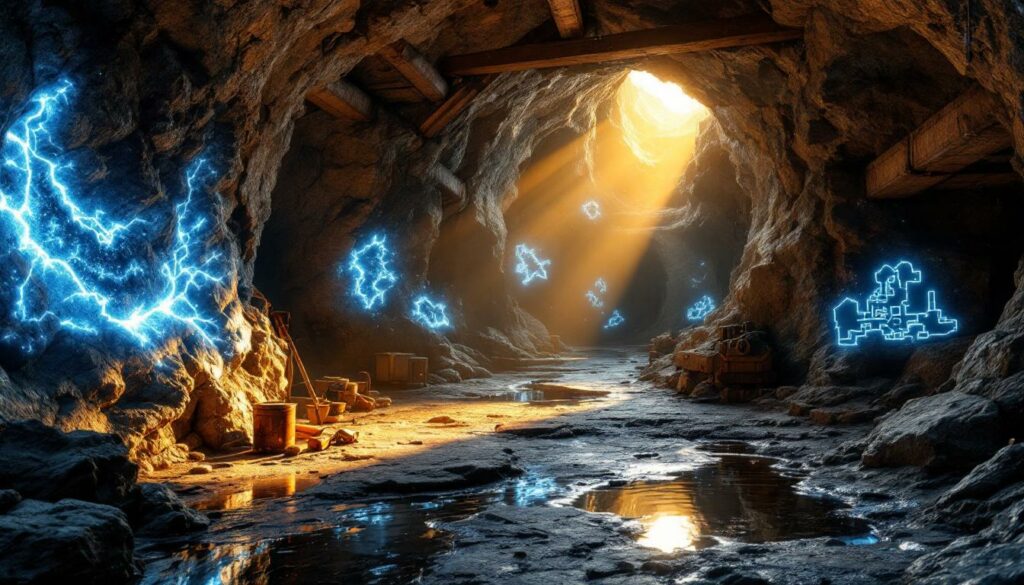The Digital Treasury of Scotland's Mining Past: Exploring Abandoned Scottish Mines
In a significant development for Scotland's geological and historical research, the British Geological Survey (BGS) has digitized and released over 500 historical plans of abandoned non-coal mines across Scotland. This extensive digital archive, accessible through the BGS Plans Viewer platform, offers unprecedented insight into Scotland's rich mining heritage while providing crucial data for modern land development, environmental management, and research purposes.
The British Geological Survey's Digital Archive Initiative
The National Geoscience Data Centre (NGDC), operating as part of the British Geological Survey, has undertaken the mammoth task of digitizing centuries-old mining documents. This initiative represents a significant commitment to making valuable geological data accessible to the public, researchers, and industry professionals.
The digital collection primarily encompasses non-coal mining operations throughout Scotland, with detailed plans of sites including the notable Garscube Colliery and Garibaldi Clayband Ironstone Workings. These digitized records provide critical information about Scotland's historical extraction of various minerals and materials.
The archives include detailed documentation of:
- Metalliferous mines extracting lead, zinc, and silver
- Extensive ironstone workings across the Central Belt
- Limestone quarries that supported Scotland's agricultural revolution
- Clay extraction sites essential for pottery and brick production
- Historical mineral exploration insights dating back to the 18th century
Why These Abandoned Mine Plans Matter Today
The release of these historical mining records serves multiple critical purposes in modern Scotland, from preserving cultural heritage to ensuring public safety and enabling responsible development.
Geological and Historical Significance
These plans constitute irreplaceable documentation of Scotland's industrial heritage, recording operations that formed the backbone of the country's economic development. Many of these abandoned Scottish mines operated during Scotland's industrial revolution when the country emerged as a global manufacturing powerhouse.
The collection reveals how mining techniques evolved over centuries, with some documents showcasing primitive hand-drawn maps alongside later, more sophisticated surveying methods. Approximately 90% of the plans include depth markers and geological strata information, providing invaluable historical context about mining practices and geological understanding of previous eras.
"These aren't just old maps—they're a comprehensive record of Scotland's underground industrial heritage that shaped communities and landscapes for generations." – British Geological Survey
Modern Applications for Land Development
For today's construction and development sectors, these historical records provide essential information that can prevent costly mistakes and dangerous situations. Access to accurate historical mine plans allows developers to:
- Conduct thorough risk assessments before breaking ground
- Understand subsurface conditions that might affect structural stability
- Identify potential void spaces requiring remediation
- Design appropriate foundation systems for potentially unstable ground
- Implement specialized ground stabilization techniques when necessary
In economic terms, the availability of these plans represents significant value. Industry estimates suggest an 80% reduction in ground investigation costs when accurate historical mining records are available before development begins.
Environmental Management Benefits
From an environmental perspective, the digitized plans serve as crucial tools for:
- Identifying potential sources of mine water pollution affecting waterways
- Planning effective remediation efforts for contaminated land
- Assessing flood risks associated with abandoned mine workings
- Monitoring long-term environmental impacts of historical mining
- Developing sustainable mining waste management solutions
The plans are particularly valuable for tracking acid mine drainage issues, which affect approximately 45 Scottish waterways according to Scottish Environment Protection Agency data from 2024.
Accessing Scotland's Underground History
The BGS has created specialized digital infrastructure to make these historical records accessible to everyone from academic researchers to property developers and environmental consultants.
The BGS Plans Viewer Platform
The digitized plans are now publicly accessible through the British Geological Survey's dedicated plans viewer. This user-friendly platform allows users to:
- Browse high-resolution scans of original historical documents
- Download digital copies in various formats (JPEG, PDF, georeferenced TIFF)
- Access comprehensive metadata for each plan
- Utilize GIS integration capabilities for spatial analysis
- Cross-reference plans with other geological datasets
This platform democratizes access to information that was previously difficult to obtain, requiring physical visits to archives and specialized knowledge to interpret.
Navigation and Search Functionality
To make locating specific mine plans straightforward, the platform offers several search methods:
- Geographic search: Find mines by region, county, or specific coordinates
- Keyword search: Locate plans by mine name, owner, or mineral type
- Time period filtering: Narrow results to specific historical periods
- Interactive map navigation: Visually browse mining areas across Scotland
- Advanced search parameters: Combine multiple criteria for precise results
The system's intuitive design ensures that both professional users and interested members of the public can effectively navigate Scotland's mining history.
What Information Do These Historical Mine Plans Contain?
The value of these documents lies in their remarkable level of detail, capturing not just mine layouts but also geological observations, operational notes, and technical specifications.
Technical Details and Mapping Elements
Most plans include impressively detailed technical information:
- Precise underground tunnel layouts with measurements
- Shaft locations, depths, and construction methods
- Geological cross-sections showing rock formations and fault lines
- Mineral seam thickness measurements and quality notations
- Survey markers and reference points for spatial accuracy
Mining engineers and surveyors of previous centuries maintained meticulous records, often using standardized symbols (shafts marked with ⦻, adits with →, coal seams with ■) following 19th-century conventions as noted in the BGS Legend Guide.
Historical Context and Operational Records
Beyond technical data, many plans provide fascinating glimpses into mining operations:
- Dates of operation and formal abandonment
- Names of mine owners, engineers, and surveyors
- Notes on mining methods and equipment utilized
- Production statistics and mineral yield records
- Observations about challenges encountered during operations
Some plans even include handwritten notes about dangerous conditions, water inrushes, or particularly rich mineral finds, offering unparalleled insights into day-to-day mining operations of past centuries.
Modern Applications Across Different Sectors
The digital availability of these historical records has opened new possibilities across multiple industries and research fields.
Engineering and Construction Applications
For civil engineers and construction companies, these plans have become essential references:
- Pre-development site investigations: Identifying potential subsurface hazards
- Foundation design optimization: Creating appropriate systems for areas with mining history
- Risk mitigation planning: Developing strategies to address potential void spaces
- Excavation safety protocols: Ensuring worker safety in areas with abandoned workings
- Ground stabilization planning: Determining where specialized techniques are required
According to the Civil Engineering Quarterly (2024), access to accurate mine plans can reduce ground investigation costs by up to 80%, representing significant project savings.
Academic and Research Utilization
The academic community has embraced this resource for diverse research purposes:
- Historical mining research: Documenting industrial archaeology and heritage
- Geological studies: Analyzing historical mineral deposits and formations
- Environmental impact assessment: Studying long-term effects of mining activities
- Educational resources: Supporting university curricula in geology and mining engineering
- Interdisciplinary research: Connecting geology with economic and social history
Over 25 UK universities now integrate these plans into their geology and engineering curricula, according to Higher Education Statistics Agency data from 2024.
Environmental Consulting and Remediation
Environmental professionals leverage these plans to address legacy pollution issues:
- Heavy metal contamination mapping: Pinpointing potential sources based on historical workings
- Mine water treatment planning: Designing effective remediation systems
- Acid mine drainage mitigation: Addressing ongoing water quality challenges
- Site-specific remediation strategies: Developing targeted approaches based on historical operations
- Long-term monitoring program design: Creating effective oversight for former mining areas
This data-driven approach helps prioritize limited remediation resources for maximum environmental benefit, a key component of modern data-driven mining operations.
Challenges Presented by Abandoned Mines in Scotland
Despite their historical significance, abandoned Scottish mines create ongoing challenges requiring careful management and mitigation.
Ground Stability Concerns
Abandoned mines pose significant geotechnical issues:
- Surface subsidence: Gradual ground settlement over collapsed workings
- Crown hole formation: Sudden collapse creating dangerous surface depressions
- Differential settlement: Uneven ground movement damaging structures
- Shaft collapse hazards: Deterioration of old mine entries
- Void migration: Underground spaces gradually moving toward the surface
The BGS Subsidence Database records over 300 mine-related subsidence events annually across Scotland, highlighting the persistent nature of these hazards.
Water Management Issues
The interaction between abandoned mines and water systems creates complex challenges:
- Flooded workings: Abandoned tunnels and chambers filling with groundwater
- Contaminated discharge: Mine water affecting surface water quality
- Altered groundwater patterns: Changed flow regimes affecting water supplies
- Construction hazards: Potential for sudden inrushes during excavation
- Long-term acid drainage: Ongoing chemical reactions creating acidic water
The Leadhills mining district in South Lanarkshire exemplifies these challenges, with persistent water quality issues stemming from 18th-century lead and zinc mining operations that continue to affect local ecosystems.
Case Studies of Problematic Sites
Several notable examples demonstrate these ongoing challenges:
-
Leadhills and Wanlockhead: Scotland's highest villages struggle with heavy metal contamination from historical lead mining.
-
Glasgow's urban mining legacy: Residential areas built over former workings experience periodic subsidence issues.
-
Central Belt infrastructure challenges: Transportation projects encountering unexpected voids during construction.
-
Midlothian coal field water management: Ongoing pumping requirements to prevent groundwater contamination.
-
East Ayrshire opencast restoration: Addressing landscape and water quality issues from more recent mining operations.
These cases highlight the importance of accurate historical records in addressing legacy mining challenges.
Scotland's Mining Heritage in Global Context
Scotland's approach to documenting and managing its mining legacy offers interesting comparisons to other regions with similar industrial histories.
Unique Aspects of Scottish Mining Heritage
Scotland's mining history has several distinctive characteristics:
- Geological diversity: From Highlands gold to Lowlands coal, Scotland's varied geology created a diverse mining industry
- Early technological innovation: Scottish engineers pioneered many mining techniques later adopted globally
- Regulatory evolution: Scotland developed mine recording regulations earlier than many regions
- Cultural integration: Mining traditions deeply embedded in Scottish community identities
- Landscape impacts: Distinct visual and environmental signatures from different types of mining
With a mine density of 2.1 sites per square kilometer (compared to 0.8 in Wales), Scotland's landscape has been particularly shaped by its mining past.
International Comparisons and Best Practices
Looking at how other regions manage abandoned mines provides valuable context:
| Country/Region | Digital Archive Approach | Remediation Funding | Public Access |
|---|---|---|---|
| Scotland (UK) | Comprehensive digitization | Government + developer | Full public access |
| Germany (Ruhr) | Centralized database | Industry levy | Limited access |
| United States | State-by-state records | Superfund + bonds | Varies by state |
| Australia | Fragmented by territory | Mining company bonds | Restricted access |
| Canada | Provincial responsibility | Mixed public/private | Partial access |
Germany's approach to the Ruhr Valley's mining heritage demonstrates how centralized record-keeping can reduce subsidence risks and improve development planning. However, unlike Scotland's open access model, the German system restricts certain information to qualified professionals.
Future Applications of Mine Plan Data
The digitized plans create opportunities for innovative approaches to Scotland's post-industrial landscape.
Renewable Energy Opportunities
Abandoned mines offer unique potential for green energy development:
- Geothermal energy extraction: Utilizing stable temperatures in flooded workings
- Pumped hydro storage: Using suitable mine systems for energy storage
- Mine water heat recovery: Extracting thermal energy for district heating
- Underground energy storage: Repurposing suitable spaces for compressed air or hydrogen
- Integrated renewable systems: Combining mine resources with surface installations
Technical studies from Glasgow University (2023) indicate that flooded mine shafts can provide approximately 5 kW of heat output per shaft, offering significant potential for low-carbon heating across Scotland's former mining regions.
Heritage Tourism Development
Scotland's mining past presents opportunities for cultural and educational tourism:
- Mining heritage trails: Connecting surface features and museums
- Underground tourism: Developing safe access to selected mine workings
- Digital heritage experiences: Creating virtual reality experiences using mine plans
- Community storytelling: Preserving mining communities' oral histories
- Economic revitalization: Creating sustainable tourism in former mining areas
VisitScotland data indicates that mining heritage sites already attract approximately 500,000 visitors annually, suggesting significant potential for expansion with improved interpretation and access.
Innovative Land Reclamation Projects
Creative approaches to post-mining landscapes include:
- Habitat creation: Developing specialized ecosystems on former mining land
- Recreational spaces: Converting mining features into outdoor activity areas
- Water management systems: Creating sustainable drainage using mining infrastructure
- Agricultural innovation: Developing specialized farming adapted to post-mining soils
- Community-led regeneration: Empowering local communities to reimagine former mining land
The Scottish Government's 2026 pilot project in Stirling, which will use mine water for district heating, exemplifies how historical mining infrastructure can be repurposed for contemporary needs through mine reclamation innovations.
Frequently Asked Questions About Abandoned Scottish Mines
What safety precautions should property owners take near abandoned mines?
Property owners in former mining areas should:
- Commission a Coal Authority or BGS mining report before purchase
- Consult with geotechnical engineers about potential risks
- Review available mine plans through the BGS viewer
- Consider specialized insurance coverage for mining-related issues
- Implement ground investigation techniques if development is planned
- Monitor for signs of subsidence (cracks, tilting, drainage changes)
How accurate are these historical mine plans?
The accuracy of historical mine plans varies significantly:
- Pre-1850s plans: Often more schematic than precisely measured
- Late 19th century plans: Generally more accurate but with limited surveying technology
- 20th century documents: Typically meet higher standards of accuracy
- Depth measurements: More reliable than horizontal positioning in many cases
- Surface features: Usually accurately recorded for reference purposes
All historical plans should be used as guides rather than definitive records and supplemented with modern 3D geological modelling where critical decisions are involved.
Can these abandoned mines be reopened for modern mining?
Reopening abandoned mines involves multiple considerations:
- Geological assessment: Evaluating remaining mineral resources
- Structural evaluation: Determining stability of historical workings
- Environmental impact: Addressing legacy contamination
- Regulatory hurdles: Meeting modern mining standards
- Economic viability: Balancing extraction costs against mineral value
While technically possible in some cases, reopening typically requires significant investment in remediation and infrastructure. Each site requires individual evaluation based on current geological understanding and market conditions.
What responsibilities do landowners have regarding abandoned mines on their property?
Landowners generally must:
- Maintain safe conditions on their property
- Secure dangerous mine entries to prevent unauthorized access
- Monitor for signs of subsidence or collapse
- Disclose known mining features when selling property
- Comply with any specific notices issued by the Coal Authority or local councils
- Address environmental issues like mine water discharge under SEPA regulations
These responsibilities vary based on the specific type of mining, with coal mines subject to different regulations than metalliferous mines.
How do abandoned mines affect property values?
The impact on property values depends on several factors:
- Proximity to workings: Surface features typically have greater impact
- Type of mining: Coal mining effects are often more significant than other minerals
- Age and depth of workings: Older, deeper mines generally pose lower risks
- Evidence of previous issues: Properties with historical subsidence typically face larger value impacts
- Remediation status: Successfully treated sites may see minimal value effects
Professional mining surveys during property transactions help quantify risks and provide greater certainty for buyers and lenders.
Exploring Scotland's Mining Heritage Further
For those interested in deeper exploration of Scotland's mining past, several resources complement the BGS mine plans:
- The National Mining Museum Scotland provides context on mining communities and technologies
- The BGS GeoIndex offers additional geological data to enhance understanding of mining regions
- Local archives often contain complementary records including photographs and worker accounts
- University special collections frequently hold mining company records and engineering documents
- Community heritage groups in former mining areas maintain oral histories and artifacts
These resources collectively help preserve Scotland's rich mining heritage while providing essential information for addressing its complex legacy.
Want to Stay Ahead on ASX Mineral Discoveries?
Receive real-time alerts on significant ASX mineral discoveries with Discovery Alert's proprietary Discovery IQ model, helping you identify actionable opportunities before the broader market. Explore why major mineral discoveries can lead to exceptional returns by visiting Discovery Alert's dedicated discoveries page and begin your 30-day free trial today.




